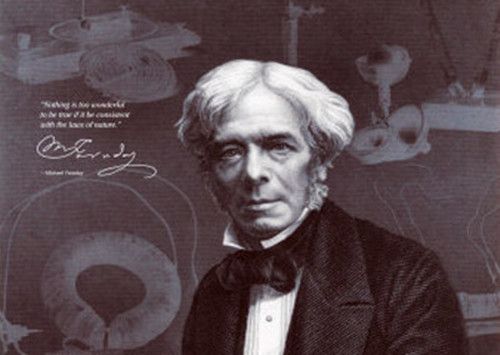迈克尔·法拉第 (Michael Faraday,公元1791~公元1867) 英国物理学家、化学家,也是著名的自学成才的科学家。生于萨里郡纽因顿一个贫苦铁匠家庭。仅上过小学。1831年,他作出了关于力场的关键性突破,永远改变了人类文明。1815年5月回到皇家研究所在戴维指导下进行化学研究。1824年1月当选皇家学会会员,1825年2月任皇家研究所实验室主任,1833----1862任皇家研究所化学教授。1846年荣获伦福德奖章和皇家勋章。

英文简介:
The English chemist and physicist Michael Faraday, b. Sept. 22, 1791, d.Aug. 25, 1867,is known for his pioneering experiments in electricity andmagnetism.Many consider him the greatest experimentalist who ever lived.
Several concepts that he derived directly from experiments, such as lines of magnetic force, have become common ideas in modern physics.
Faraday was born at Newington, Surrey, near London. He received little more than a primary education, and at the age of 14 he was apprenticed to a bookbinder. There he became interested in the physical and chemical works of the time. After hearing a lecture by the famous chemist Humphry Davy, he sent Davy the notes he had made of his lectures. As a result Faraday was appointed, at the age of 21, assistant to Davy in the laboratory of the Royal Institution in London.
During the initial years of his scientific work, Faraday occupied himself mainly with chemical problems.He discovered two new chlorides of carbon and succeeded in liquefying chlorine and other gases. He isolated benzene in 1825, the year in which he was appointed director of the laboratory.
Davy, who had the greatest influence on Faraday's thinking, had shown in 1807 that the metals sodium and potassium can be precipitated from their compounds by an electric current, a process known as electrolysis.
Faraday's vigorous pursuit of these experiments led in 1834 to what became known as Faraday's laws of electrolysis.
Faraday's research into electricity and electrolysis was guided by the belief that electricity is only one of the many manifestations of the unified forces of nature, which included heat, light, magnetism, and chemical affinity. Although this idea was erroneous, it led him into the field of electromagnetism, which was still in its infancy.
In 1785, Charles Coulomb had been the first to demonstrate the manner in which electric charges repel one another, and it was not until 1820 that Hans Christian Oersted and Andre Marie Ampere discovered that an electric current produces a magnetic field. Faraday's ideas about conservation of energy led him to believe that since an electric current could cause a magnetic field, a magnetic field should be able to produce an electric current. He demonstrated this principle of induction in 1831. Faraday expressed the electric current induced in the wire in terms of the number of lines of force that are cut by the wire.
The principle of induction was a landmark in applied science, for it made possible the dynamo, or generator, which produces electricity by mechanical means.
Faraday's introduction of the concept of lines of force was rejected by most of the mathematical physicists of Europe, since they assumed that electric charges attract and repel one another, by action at a distance, making such lines unnecessary. Faraday had demonstrated the phenomenon of electromagnetism in a series of experiments, however.
This experimental necessity probably led the physicist James Clerk Maxwell to accept the concept of lines of force and put Faraday's ideas into mathematical form, thus giving birth to modern field theory.
Faraday's discovery (1845) that an intense magnetic field can rotate the plane of polarized light is known today as the Faraday effect. The phenomenon has been used to elucidate molecular structure and has yielded information about galactic magnetic fields.
Faraday described his numerous experiments in electricity and electromagnetism in three volumes entitled Experimental Researches in Electricity (1839, 1844, 1855); his chemical work was chronicled in Experimental Researches in Chemistry and Physics (1858). Faraday ceased research work in 1855 because of declining mental powers, but he continued as a lecturer until 1861. A series of six children's lectures published in 1860 as The Chemical History of a Candle, has become a classic of science literature.
以上就是成都出国留学服务中心为您提供SAT写作素材:名人简介之法拉第(Faraday)的全部内容,更多内容请进入学习资料 查看